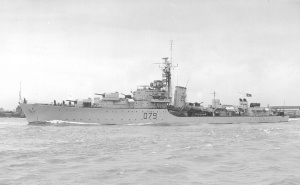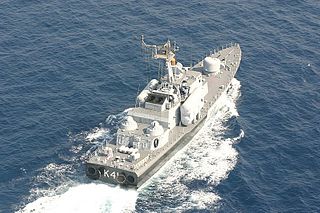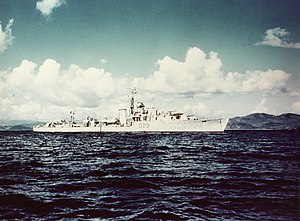
The Type 14 Blackwood class were a ship class of minimal "second-rate" anti-submarine warfare frigates. Built for the Royal Navy during the 1950s at a time of increasing threat from the Soviet Union's submarine fleet, they served until the late 1970s. Twelve ships of this class served with the Royal Navy and a further three were built for the Indian Navy.

HMS Cadiz was a Battle-class destroyer of the Royal Navy. She was named after the Battle of Cádiz, in which the French besieged the Spanish town in 1810, which was eventually lifted in 1812 after the French defeat at the Battle of Salamanca.
Four ships of the British Royal Navy have been named HMS Charity:
PNS Shah Jahan of Shahjahan may refer to one of the following ships of the Pakistan Navy:

A missile boat or missile cutter is a small, fast warship armed with anti-ship missiles. Being smaller than other warships such as destroyers and frigates, missile boats are popular with nations interested in forming a navy at lower cost. They are similar in concept to the torpedo boats of World War II; in fact, the first missile boats were modified torpedo boats with the torpedo tubes replaced by missile tubes.

Operation Trident was an offensive operation launched by the Indian Navy on Pakistan's port city of Karachi during the Indo-Pakistani War of 1971. Operation Trident saw the first use of anti-ship missiles in combat in the region. The operation was conducted on the night of 4–5 December and inflicted heavy damage on Pakistani vessels and facilities. While India suffered no losses, Pakistan lost a minesweeper, a destroyer, a cargo vessel carrying ammunition, and fuel storage tanks in Karachi. Another destroyer was also badly damaged and eventually scrapped. India celebrates its Navy Day annually on 4 December to mark this operation. Trident was followed up by Operation Python three days later.
Operation Python, a follow-up to Operation Trident, was the code name of a naval attack launched on West Pakistan's port city of Karachi by the Indian Navy during the Indo-Pakistani War of 1971. After the first attack during Operation Trident on the Port of Karachi, Pakistan stepped up aerial surveillance of its coast as the presence of large Indian Navy ships gave the impression that another attack was being planned. Pakistani warships attempted to outsmart the Indian Navy by mingling with merchant shipping. To counter these moves, Operation Python was launched on the night of 8/9 December 1971. A strike group consisting of one missile boat and two frigates attacked the group of ships off the coast of Karachi. While India suffered no losses, Pakistani fleet tanker PNS Dacca was damaged beyond repair, and the Kemari Oil Storage facility was lost. Two other foreign ships stationed in Karachi were also sunk during the attack.

Naval tactics and doctrine is the collective name for methods of engaging and defeating an enemy ship or fleet in battle at sea during naval warfare, the naval equivalent of military tactics on land.

The Veer-class corvettes of the Indian Navy are a customised Indian variant of the Soviet Tarantul class. They form the 22nd Missile Vessel Squadron.
The Vidyut-class missile boats of the Indian Navy were an Indian variant of the Soviet Osa I class.
INS Veer (K82) (Brave) was a Vidyut-class missile boat of the Indian Navy.
INS Nipat (K86) was a Vidyut-class missile boat of the Indian Navy. It was part of the 25th "Killer" Missile squadron.
'INS Nirghat (K89) was a Vidyut-class missile boat of the Indian Navy.
The Indo-Pakistani Naval War of 1971 refers to the maritime military engagements between the Indian Navy and the Pakistan Navy during the Indo-Pakistani War of 1971. The series of naval operations began with the Indian Navy's exertion of pressure on Pakistan from the Indian Ocean, while the Indian Army and Indian Air Force moved in to choke Pakistani forces operating in East Pakistan on land. Indian naval operations comprised naval interdiction, air defence, ground support, and logistics missions.
PNS Muhafiz was an Adjutant-class minesweeper of the Pakistan Navy. It was built by the United States for transfer to Pakistan. PNS Muhafiz was sunk by a missile from INS Veer of the Indian Navy during the Indo-Pakistani War of 1971.

PNS Zulfiqar was a River-class frigate of the Pakistan Navy, originally built for the Royal Navy during the Second World War as HMS Deveron. Zulfiqar was damaged beyond repair by friendly fire from aircraft of the Pakistan Air Force (PAF) which mistook her for a missile boat of the Indian Navy during the Indo-Pakistani War of 1971.
Lt. Com. Bahadur Nariman KavinaVrC was a prominent Indian naval officer, who was commanding officer of the INS Nipat. During the Indo-Pakistani War of 1971, Kavina was the chief architect of attack on the Port of Karachi and led the successful attack on Pakistani Navy headquarters.

PNS Tippu Sultan (DDG-185), a Tariq-class destroyer, served in the Pakistan Navy after it was acquired in 1994. Her design was based on the British Type 21 frigate, and previously served in the Royal Navy as HMS Avenger as a general purpose frigate.

PNS Shah Jahan (DDG-186) was a Tariq-class destroyer in service with the Pakistan Navy since being recommissioned in 1994. Based on the British design, Type 21 frigate, she previously served in the Royal Navy as HMS Active as a general purpose frigate.

The 22nd Missile Vessel Squadron, commonly referred to as the Killer Squadron, is a formation of the Indian Navy, composed primarily of Veer-class corvettes. This squadron, based in Mumbai, was officially established in October 1991 with a complement of ten Veer-class and three Prabal-class missile boats. However, the roots of the Killer Squadron trace back to 1969, when the Indian Navy inducted Osa-class missile boats from the Soviet Union. These vessels were transported to India on heavy lift merchant ships and were commissioned in early 1971 at Kolkata. The squadron quickly demonstrated its prowess in the Indo-Pakistani War of 1971, playing a decisive role in the conflict.










